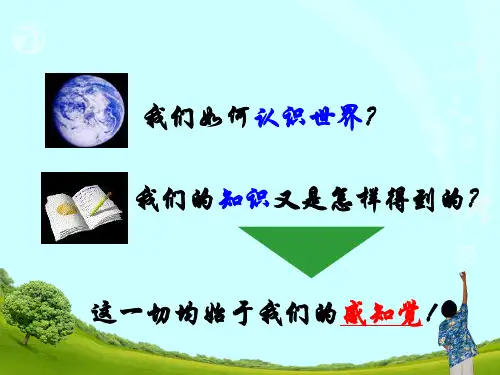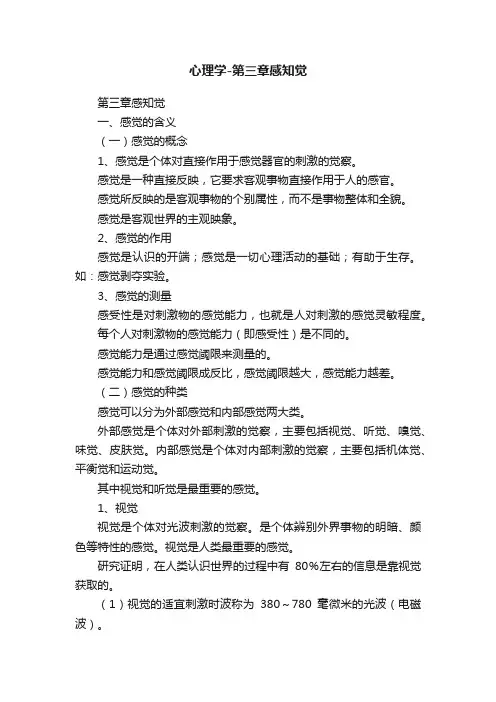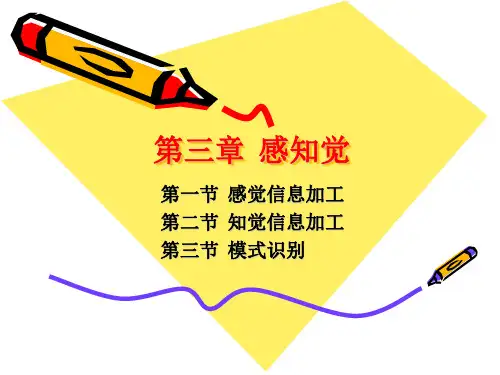心理学概论第三章感知觉
- 格式:pdf
- 大小:40.09 KB
- 文档页数:6


心理学-第三章感知觉第三章感知觉一、感觉的含义(一)感觉的概念1、感觉是个体对直接作用于感觉器官的刺激的觉察。
感觉是一种直接反映,它要求客观事物直接作用于人的感官。
感觉所反映的是客观事物的个别属性,而不是事物整体和全貌。
感觉是客观世界的主观映象。
2、感觉的作用感觉是认识的开端;感觉是一切心理活动的基础;有助于生存。
如:感觉剥夺实验。
3、感觉的测量感受性是对刺激物的感觉能力,也就是人对刺激的感觉灵敏程度。
每个人对刺激物的感觉能力(即感受性)是不同的。
感觉能力是通过感觉阈限来测量的。
感觉能力和感觉阈限成反比,感觉阈限越大,感觉能力越差。
(二)感觉的种类感觉可以分为外部感觉和内部感觉两大类。
外部感觉是个体对外部刺激的觉察,主要包括视觉、听觉、嗅觉、味觉、皮肤觉。
内部感觉是个体对内部刺激的觉察,主要包括机体觉、平衡觉和运动觉。
其中视觉和听觉是最重要的感觉。
1、视觉视觉是个体对光波刺激的觉察。
是个体辨别外界事物的明暗、颜色等特性的感觉。
视觉是人类最重要的感觉。
研究证明,在人类认识世界的过程中有80%左右的信息是靠视觉获取的。
(1)视觉的适宜刺激时波称为380~780毫微米的光波(电磁波)。
(2)颜色视觉①颜色的基本特性颜色是光波作用于人眼所引起的视觉经验。
颜色具有色调、明度、饱和度三种特性。
这些特性是由光波的物理特性决定的。
②色觉异常:色觉异常主要包括色弱和色盲两类。
2、听觉听觉是个体对声音刺激的觉察。
(1)听觉是适宜刺激是频率为16~20000HZ的声波,人耳最敏感的声波频率是1000~4000HZ。
(2)听觉的基本特性人类的听觉具有音调、音响、音高三种特性。
3、嗅觉嗅觉是由有气味的气体物质引起的。
4、味觉味觉的适宜刺激是溶于水的化学物质。
5、皮肤觉刺激作用于皮肤引起各种各样的感觉,叫皮肤觉(肤觉)。
皮肤感觉可以分为触觉、冷觉、温觉、痛觉等。
6、动觉动觉也叫运动感觉,它反应身体各部分的位置、运动以及肌肉的紧张程度,是内部感觉的一种重要形态。









Chapter 3 Sensation and Perception第三章感知觉There are four modules in this chapter. Module 8 tells us the concept of sense; module 9 introduces vision of human and how do we see the world; module 10 tells us how can we hear and feel the world; at last, we can learn from module 11 that how do we construct our view of the world—perception.MODULE 8 SENSING THE WORLD AROUND USIn all sensory processes, some form of energy stimulates a receptor cell in one of the sense organs. The receptor cell converts that energy into a neural signal, which is further coded as it travels along sensory nerves. By the time it reaches the brain, the message is quite precise.Sensation is the experience of sensory stimulation. Perception is the process of creating meaningful patterns from raw sensory information. Stimuli are the energy that produces a response in a sense organ.Sensory ThresholdsThe energy reaching a receptor must be sufficiently intense to produce a noticeable effect. The least amount of energy needed to generate any sensation at all in a person 50 percent of the time is called the absolute threshold. The difference threshold or the just noticeable difference (jnd) is the smallest change in stimulation that is detectable 50 percent of the time. Generally speaking, the stronger the stimulation, the bigger the change must be to be sensed. According to Weber's law, the jnd for a given sense is a constant fraction of the original stimulus. In most cases, our senses adjust to the level of stimulation they are experiencing, a process known as adaptation.MODULE 9 VISIONUnlike most animals, humans rely most heavily on their sense of vision to perceive the world.The Visual SystemIn the process leading to vision, light enters the eye through the cornea, then passes through the pupil(in the center of the iris) and the lens, which focuses it onto the retina. The lens changes its shape to allow light to be focused sharply on the retina. Directly behind the lens and on the retina is a depressed spot called the fovea, which lies at the center of the visual field. The retina of each eye contains the two kinds of receptor cells responsible for vision: rods and cones. Rods, chiefly responsible fornight vision, respond to varying degrees of light and dark but not to color. Cones respond to light and dark as well as to color or different wavelengths of light, and operate mainly in daytime. Only cones are present in the fovea.Rods and cones connect to nerve cells, called bipolar cells, leading to the brain. In the fovea, a single cone generally connects with one bipolar cell. Rods, on the other hand, share bipolar cells. The one-to-one connection between cones and bipolar cells in the fovea allows for maximum visual acuity, the ability to distinguish fine details. Vision is thus sharpest whenever the image of an object falls directly on the fovea; outside the fovea, acuity drops dramatically. The sensitivity of rods and cones changes according to the amount of available light. Light adaptation helps our eyes adjust to bright light; dark adaptation allows us to see, at least partially, in conditions of darkness. An afterimage can appear until the retina adapts after a visual stimulus has been removed.Neural messages originating in the retina must eventually reach the brain for a visual sensation to occur. The bipolar cells connect to ganglion cells, whose axons converge to form the optic nerve that carries messages to the brain. The place on the retina where the axons of the ganglion cells join to leave the eye is the blind spot.At the base of the brain is the optic chiasm, where some of the optic nerve fibers cross to the other side of the brain.Color VisionThe human vision system allows us to see an extensive range of colors. Hue, saturation, and brightness are three separate aspects of our experience of color. Hue refers to colors (red, green, blue, etc.), saturation indicates the vividness or richness of the hues, and brightness signals the intensity of the hues. Humans can distinguish only about 150 hues but, through gradations of saturation and brightness, we can perceive about 300,000 colors. Theories of color vision attempt to explain how the cones, which number only about 150,000 in the fovea, are able to distinguish some 300,000 different colors. One clue lies in color mixing: Additive color mixing is the process of mixing only a few lights of different wavelengths to create many new colors; subtractive color mixing refers to mixing a few pigments to come up with a whole palette of new colors.Based on the principles of additive color mixing, the trichromatic theory of color vision holds that the eye contains three kinds of color receptors that are most responsive to either red, green, or blue light. By combining signals from these three basic receptors, the brain can detect any color and even subtle differences among nearly identical colors. This theory accounts for some kinds of colorblindness. People referred to as dichromats have a deficiency in either red-green or blue-yellow vision; monochromats see no color at all. People with normal color vision are referred to as trichromats. By contrast, the opponent-process theory maintains that receptors are specialized to respond to either member of the three basic color pairs: red-green, yellow-blue, and black-white (dark and light).Drawing on elements of the two theories, current knowledge holds that while there are three kinds of receptors for colors in the retina (for violet-blue, green, and yellow light), the messages they transmit are coded by other neurons in the visual system into opponent-process form.MODULE 10 HEARING AND OTHER SENCESSounds we hear are psychological experiences created by the brain in response to stimulation.The physical stimuli for the sense of hearing are sound waves, which produce vibration in the eardrum. Frequency is the number of cycles per second in a wave, expressed in a unit called hertz. Frequency is the primary determinant of pitch—how high or low the tone seems to be. Amplitude is the magnitude of a wave; it largely determines the loudness of a sound. Loudness is measured in decibels. The complex pattern of overtones determines the timbre of a sound.The EarHearing begins when sound waves strike the eardrum and cause it to vibrate. This vibration, in turn, makes three bones in the middle ear—the hammer, the anvil, and the stirrup—vibrate in sequence. These vibrations are magnified in their passage through the middle ear deep into the inner ear. The oval window, which is attached to the stirrup, and the round window are membranes between the middle and inner ear. In the inner ear, the vibrations cause the fluid inside the cochlea to vibrate, pushing the basilar membrane and the organ of Corti up and down.Inside the organ of Corti are tiny hair cells that act as sensory receptors for hearing. Stimulation of these receptors produces auditory signals that are transmitted to the brain through the auditory nerve. The brain pools the information from thousands of these cells to create the perception of sounds.Theories of HearingThere are two basic views that explain how different sound-wave patterns are coded into neural messages. Place theory states that the brain determines pitch by noting the place on the basilar membrane where the message is strongest. Frequency theory holds that the frequency of vibrations of the basilar membrane as a whole is translated into an equivalent frequency of nerve impulses. Neurons, however, cannot fire as rapidly as the frequency of the highest-pitched sound. This suggests a volley principle, whereby nerve cells fire in sequence to send a rapid series of impulses to the brain.THE OTHER SENSESSmellThe sense of smell is activated by substances carried by airborne molecules intothe nasal cavities, where the substances activate highly specialized receptors for smell, located in the olfactory epithelium. From there messages are carried directly to the olfactory bulb in the brain, where they are sent to the brain's temporal lobe, resulting in our awareness of smells. Pheromones are sensed by receptors in the vomeronasal organ (VNO), which sends messages to a specialized olfactory bulb.TasteThe receptor cells for the sense of taste are housed in the taste buds on the tongue, which, in turn, are found in the papillae, the small bumps on the surface of the tongue. Each taste bud contains a cluster of taste receptors, or taste cells, that cause their adjacent neurons to fire when they become activated by the chemical substances in food, sending a nerve impulse to the brain.We experience only four primary taste qualities: sweet, sour, salty, and bitter. All other tastes derive from combinations of these four. Flavor is a complex blend of taste and smell.Sensations of MotionThe vestibular organs are also responsible for motion sickness, which triggers strong reactions in some people. Motion sickness may be caused by discrepancies between visual information and vestibular sensation.The Skin SensesThe skin is the largest sense organ, with numerous nerve receptors distributed in varying concentrations throughout its surface. The nerve fibers from these receptors travel to the brain. Skin receptors give rise to what are known as the cutaneous sensations of pressure, temperature, and pain. Research has not established a simple connection between the various types of receptors and these separate sensations. Because the brain uses complex information about the patterns of activity on many different receptors to detect and discriminate among skin sensations, a direct connection between receptors and sensations has so far eluded researchers.PainPeople have varying degrees of sensitivity to pain. The most commonly accepted explanation of pain is the gate control theory, which holds that a "neurological gate" in the spinal cord controls the transmission of pain impulses to the brain. Studies of pain relief suggest the existence of the placebo effect, which occurs when a pain sufferer feels relief from pain when given a chemically neutral pill but told that it is an effective pain reliever.MODULE 11 PERCEPTIONThere are several ways in which the brain interprets the complex flow of information from the various senses and creates perceptual experiences that go far beyond what issensed directly.Perceptual OrganizationOne important way our perceptual processes work is through distinguishing figures from the ground against which they appear. The figure-ground distinction, first noted by Gestalt psychologists, pertains to all our senses, not just vision. For instance, a violin solo stands out against the "ground" of a symphony orchestra. When we use sensory information to create perceptions, we fill in the missing information, group various objects together, see whole objects, and hear meaningful sounds. Visual information in the brain is coded by cells called feature detectors, which respond to particular elements of the visual field.Perceptual ConstanciesPerceptual constancy is our tendency to perceive objects as unchanging in the face of changes in sensory stimulation. Once we have formed a stable perception of an object, we can recognize it from almost any angle. Thus, size, shape, brightness, and color constancies help us understand and relate to the world better. Memory and experience play an important part in perceptual constancy, compensating for confusing stimuli.Perceiving Distance and DepthWe can perceive distance and depth through monocular cues, from one eye, or binocular cues, which depend on the interaction of both eyes.Superposition is a monocular distance cue in which one object, by partly blocking a second, appears closer. Linear perspective is another monocular cue to distance and depth based on the fact that two parallel lines seem to come together at the horizon. Other monocular cues include aerial perspective, elevation, texture gradient, shadowing, and motion parallax.With binocular cues, the stereoscopic vision derived from combining the two retinal images makes perceptions of depth and distance clearer. Retinal disparity accounts for the different images each eye receives. Convergence is another binocular cue. Humans, apes, and some predatory animals with the ability to use binocular cues have a distinct advantage over animals whose vision is limited to monocular cues.Perceiving MovementPerception of movement is a complicated process involving both the visual messages from the retina and messages from the muscles around the eyes as they shift to follow a moving object. At times our perceptual processes trick us into believing that an object is moving when, in fact, it is stationary. Thus, there is a difference between real movement and apparent movement.Autokinetic illusion, the perceived motion created by a single stationary object, stroboscopic motion, resulting from the flashing of a series of still pictures in rapid succession, and the phi phenomenon, which occurs when lights flashed in sequenceare perceived as moving, are all examples of apparent movement.Visual IllusionsVisual illusions occur when we use a variety of sensory cues to create perceptual experiences that do not actually exist. More easily understood are physical illusions, an example of which is the bent appearance of a stick when placed in water. Perceptual illusions depend primarily on our own perceptual processes and occur because the stimulus contains misleading cues.Subliminal PerceptionSubliminal messages are messages that fall below the threshold of conscious perception and are therefore assumed to be perceived subconsciously. Some studies have indicated that, in a controlled laboratory setting, people can be influenced briefly by sensory messages that are outside their conscious awareness. No scientific studies support the claims, however, that subliminal messages in advertising influence consumer choices or that subliminal phrases in self-help tapes significantly change a person's behavior.。